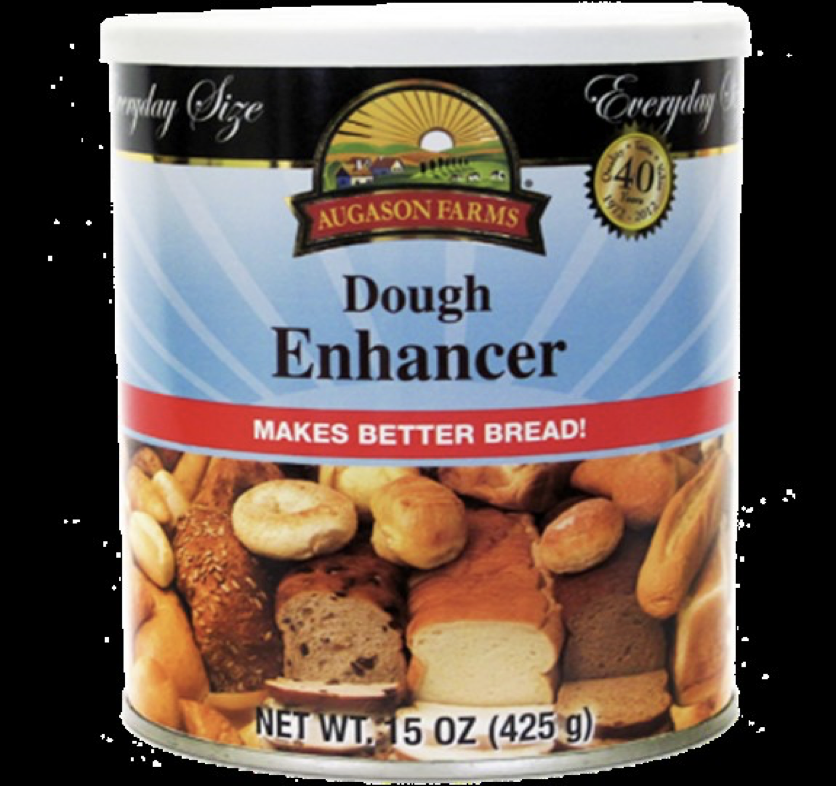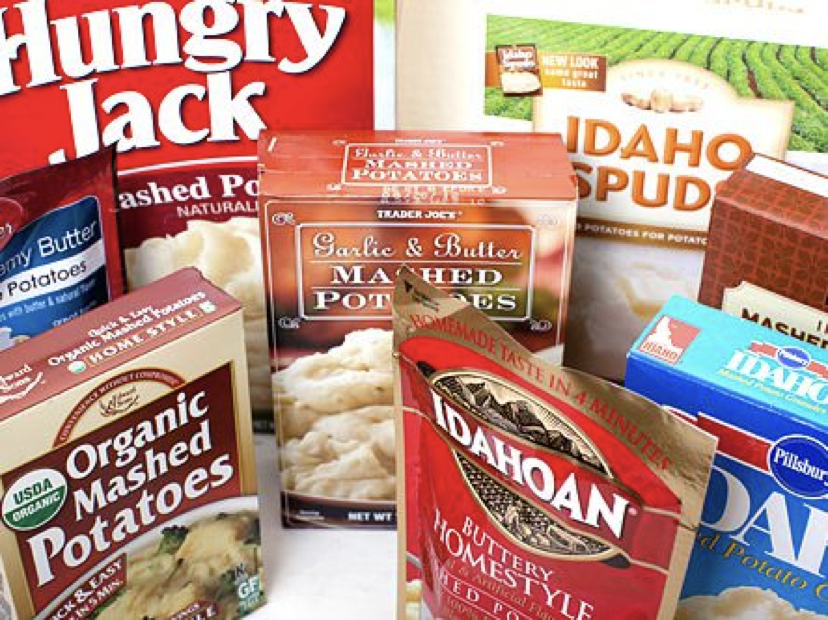Dough Enhancer: What It Is, and How to Make Your Own
Back in 2011, Crystal Godfrey, a food blogger with www.everydayfoodstorage.net, appeared on one of our local daily TV shows, “Studio 5” talking about the benefits of dough enhancer when making homemade bread. As an avid bread-maker, I was glued to the screen and followed her lead, with great success! Because my enthusiasm for using a dough enhancer never died, I eventually wrote an article on it in 2015.

I’m writing about it again, because for 20+ years now, I’ve been using dough enhancer and my bread could win awards (so says my fans—aka family). Crystal was spot on when advocating for this extra ingredient. Dough enhancer makes a huge difference in the outcome of homemade bread. So, I thought our newer readers might be glad to know this and our long-time readers might appreciate a refresher.
WHAT is a dough enhancer? To quote Crystal, “It’s a natural product that makes your bread beautiful, light, fluffy, and delicious.” Commercially, almost all breads are made with this product. On the home front, you’ll see the biggest difference when you include it in your whole wheat bread recipe, because typical whole wheat flours are heavy and coarse.

Commercial dough enhancers found in the store are made of basically four key ingredients: gluten, acid, starch, and sugar (of course they’re called other things but that’s what they are). These ingredients each serve key roles in developing a better bread texture as they contribute to the development and strengthening of the bubbles that make up your dough. Let’s look at each ingredient individually:
GLUTEN is the natural protein found in wheat. You can think of it as the elastic in a balloon.
ACID strengthens the balloon so that it doesn’t pop too early. Premature popping causes dough to collapse (very bad and very discouraging).
STARCH adds an extra layer to your balloon so it won’t break or pop (it’s like the helium that’s added to balloons to make them stay aloft). Thus, when dealing with whole wheat flour, you want to address its coarseness (so that the gluten strands don’t become weak and pop).
SUGAR this is what the yeast eats that results in the growth or rise of the dough. As it consumes the sugar, air is created that fills the “balloon” or dough bubbles.

With that homey explanation, Crystal went on to explain that you don’t have to buy a commercial dough enhancer. You can get the same results from one you make yourself. And even better news—you probably already have three of the four ingredients in your cupboard or pantry. You can use vinegar for your acid (white or apple cider), and potato flakes or instant mashed potatoes (NOT GEMS) for the starch, and any of your favorite sweeteners for the sugar (which your bread recipe already calls for).
The ingredient you may not have is the gluten. There are several brands available at most grocery and whole foods stores. Hodgson Mill and Bob’s Red Mill are two that I always see in our local grocery stores. My local Smith’s Grocery Store sells Bob’s for $7.49 (a 22-ounce package). You can also find it online.

Here is Crystal’s usage measurement for each ingredient:
GLUTEN: ½ tablespoon to 1 tablespoon per cup of flour in your recipe. Before you measure a cup of flour, place the gluten in the bottom of your cup and then measure flour as usual.
ACID: Crystal suggests using white vinegar for this. You’ll want a 1:1 ratio of yeast to vinegar.
STARCH: She also suggests using potato flakes (NOT potato pearls or gems because they don’t dissolve easily and are artificially flavored, which you’ll taste in the end product). Use 1/8 to 1/4 cup per loaf of bread (don’t be afraid to experiment to see what works best in your recipe). And a special note: don’t try to substitute potato flour for the potato flakes. Your results won’t be as satisfactory.

SUGAR: This can be any sweetener you prefer. I make my bread with either raw honey or date sugar. I’ve used white table sugar, brown sugar, and once when in a pinch, I used molasses. It’s all about taste preferences and what you have on hand. Simply follow your recipe as to how much to use.
In closing, I offer a big thanks to Crystal for sharing her skill, information, and recipe for wheat bread. She says it’s easy and delicious.

1 1/4 cups warm water
1 tablespoon active dry yeast
1/4 cup raw honey OR 1/3 cup sugar
2 3/4 cups whole wheat flour (or whatever combination white/wheat you like)
1/4 cup wheat gluten (store-bought or homemade)
1 teaspoon salt
2 tablespoons non-instant dry milk powder
1 tablespoon melted butter (olive and coconut oil work well, also)
1 tablespoon vinegar
1/4 cup instant potato flakes (NOT potato pearls or gems)
Directions:
Add Recipe to Cook'n

I’m writing about it again, because for 20+ years now, I’ve been using dough enhancer and my bread could win awards (so says my fans—aka family). Crystal was spot on when advocating for this extra ingredient. Dough enhancer makes a huge difference in the outcome of homemade bread. So, I thought our newer readers might be glad to know this and our long-time readers might appreciate a refresher.
WHAT is a dough enhancer? To quote Crystal, “It’s a natural product that makes your bread beautiful, light, fluffy, and delicious.” Commercially, almost all breads are made with this product. On the home front, you’ll see the biggest difference when you include it in your whole wheat bread recipe, because typical whole wheat flours are heavy and coarse.

Commercial dough enhancers found in the store are made of basically four key ingredients: gluten, acid, starch, and sugar (of course they’re called other things but that’s what they are). These ingredients each serve key roles in developing a better bread texture as they contribute to the development and strengthening of the bubbles that make up your dough. Let’s look at each ingredient individually:
GLUTEN is the natural protein found in wheat. You can think of it as the elastic in a balloon.
ACID strengthens the balloon so that it doesn’t pop too early. Premature popping causes dough to collapse (very bad and very discouraging).
STARCH adds an extra layer to your balloon so it won’t break or pop (it’s like the helium that’s added to balloons to make them stay aloft). Thus, when dealing with whole wheat flour, you want to address its coarseness (so that the gluten strands don’t become weak and pop).
SUGAR this is what the yeast eats that results in the growth or rise of the dough. As it consumes the sugar, air is created that fills the “balloon” or dough bubbles.

With that homey explanation, Crystal went on to explain that you don’t have to buy a commercial dough enhancer. You can get the same results from one you make yourself. And even better news—you probably already have three of the four ingredients in your cupboard or pantry. You can use vinegar for your acid (white or apple cider), and potato flakes or instant mashed potatoes (NOT GEMS) for the starch, and any of your favorite sweeteners for the sugar (which your bread recipe already calls for).
The ingredient you may not have is the gluten. There are several brands available at most grocery and whole foods stores. Hodgson Mill and Bob’s Red Mill are two that I always see in our local grocery stores. My local Smith’s Grocery Store sells Bob’s for $7.49 (a 22-ounce package). You can also find it online.

Here is Crystal’s usage measurement for each ingredient:
GLUTEN: ½ tablespoon to 1 tablespoon per cup of flour in your recipe. Before you measure a cup of flour, place the gluten in the bottom of your cup and then measure flour as usual.
ACID: Crystal suggests using white vinegar for this. You’ll want a 1:1 ratio of yeast to vinegar.
STARCH: She also suggests using potato flakes (NOT potato pearls or gems because they don’t dissolve easily and are artificially flavored, which you’ll taste in the end product). Use 1/8 to 1/4 cup per loaf of bread (don’t be afraid to experiment to see what works best in your recipe). And a special note: don’t try to substitute potato flour for the potato flakes. Your results won’t be as satisfactory.

SUGAR: This can be any sweetener you prefer. I make my bread with either raw honey or date sugar. I’ve used white table sugar, brown sugar, and once when in a pinch, I used molasses. It’s all about taste preferences and what you have on hand. Simply follow your recipe as to how much to use.
In closing, I offer a big thanks to Crystal for sharing her skill, information, and recipe for wheat bread. She says it’s easy and delicious.

EZ Wheat Bread
Ingredients:
1 1/4 cups warm water
1 tablespoon active dry yeast
1/4 cup raw honey OR 1/3 cup sugar
2 3/4 cups whole wheat flour (or whatever combination white/wheat you like)
1/4 cup wheat gluten (store-bought or homemade)
1 teaspoon salt
2 tablespoons non-instant dry milk powder
1 tablespoon melted butter (olive and coconut oil work well, also)
1 tablespoon vinegar
1/4 cup instant potato flakes (NOT potato pearls or gems)
Directions:
Mix ingredients in order listed in bowl of mixer with dough hook attachment. Mix for 12-15 minutes. Let rise until dough is doubled, approximately 1 to1½ hours. Punch down, and shape into loaf or rolls. Let rise again until doubled and bake at 375 degrees for 30 minutes until golden brown and sounds hollow when lightly tapped.
Recipe formatted with the Cook'n Recipe Software from DVO Enterprises.
Sources:
- www.augasonfarms.com
- www.world-grain.com
- www.veganricha.com
- www.walmart.com
- www.seriouseats.com
- www.fivehearthome.com
 Alice Osborne
Alice Osborne
Weekly Newsletter Contributor since 2006
Email the author! alice@dvo.com
